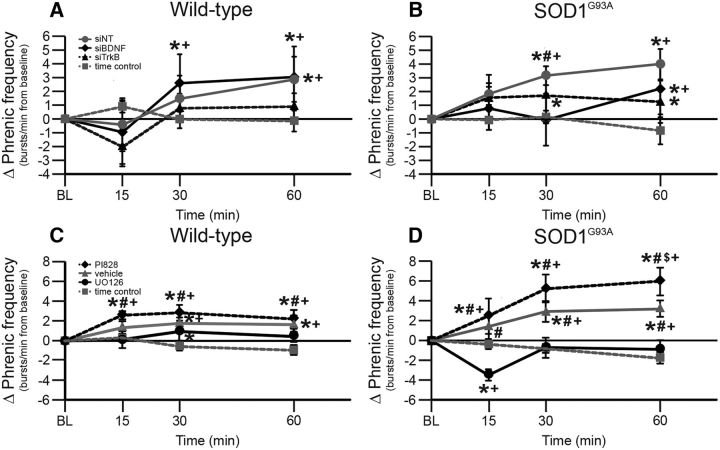Figure 5.
Burst frequency response in end-stage SOD1G93A and wild-type rats. A, B, Burst frequency response (change from baseline, bursts/min) in wild-type (A) and SOD1G93A (B) rats pretreated with siNT (gray circles with solid gray line), siTrkB (black triangles with black dashed line), or siBDNF (black diamonds with solid black line), or TCs (gray squares with gray dashed line). In A, burst frequency is significantly increased in wild-type rats treated with siNT or siBDNF compared with baseline (+) and with TCs (*). In B, burst frequency is significantly increased in SOD1G93A rats treated with siNT, siTrkB, or siBDNF compared with baseline (+) and with TCs (*). SOD1G93A rats treated with siBDNF had smaller burst frequencies compared with rats treated with siNT (#; at 30 min after hypoxia). C, D, Burst frequency response in wild-type (C) and SOD1G93A (D) rats pretreated with vehicle (gray triangles with solid gray line), PI828 (black diamonds with black dashed line), or UO126 (black circles with black solid line), or TCs (gray squares with gray dashed line). In C, burst frequency is significantly increased in wild-type rats treated with PI828, vehicle, or UO126 compared with baseline (+) and with TCs (*). UO126-treated wild-type rats had a significantly smaller burst frequency compared with PI828-treated rats (#). In D, burst frequency is significantly increased in SOD1G93A rats treated with PI828 or vehicle compared with baseline (+) and with TCs (*). UO126-treated SOD1G93A rats had a significantly smaller burst frequency compared with PI828 (#), with vehicle (#), with baseline (+; at 15 min posthypoxia), and with TCs (*; at 15 min posthypoxia). PI828-treated SOD1G93A rats also had a larger burst frequency compared with vehicle-treated rats ($; at 60 min posthypoxia). Values are means ± 1 SEM; significant differences are p < 0.05.

